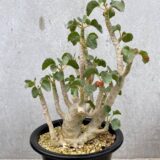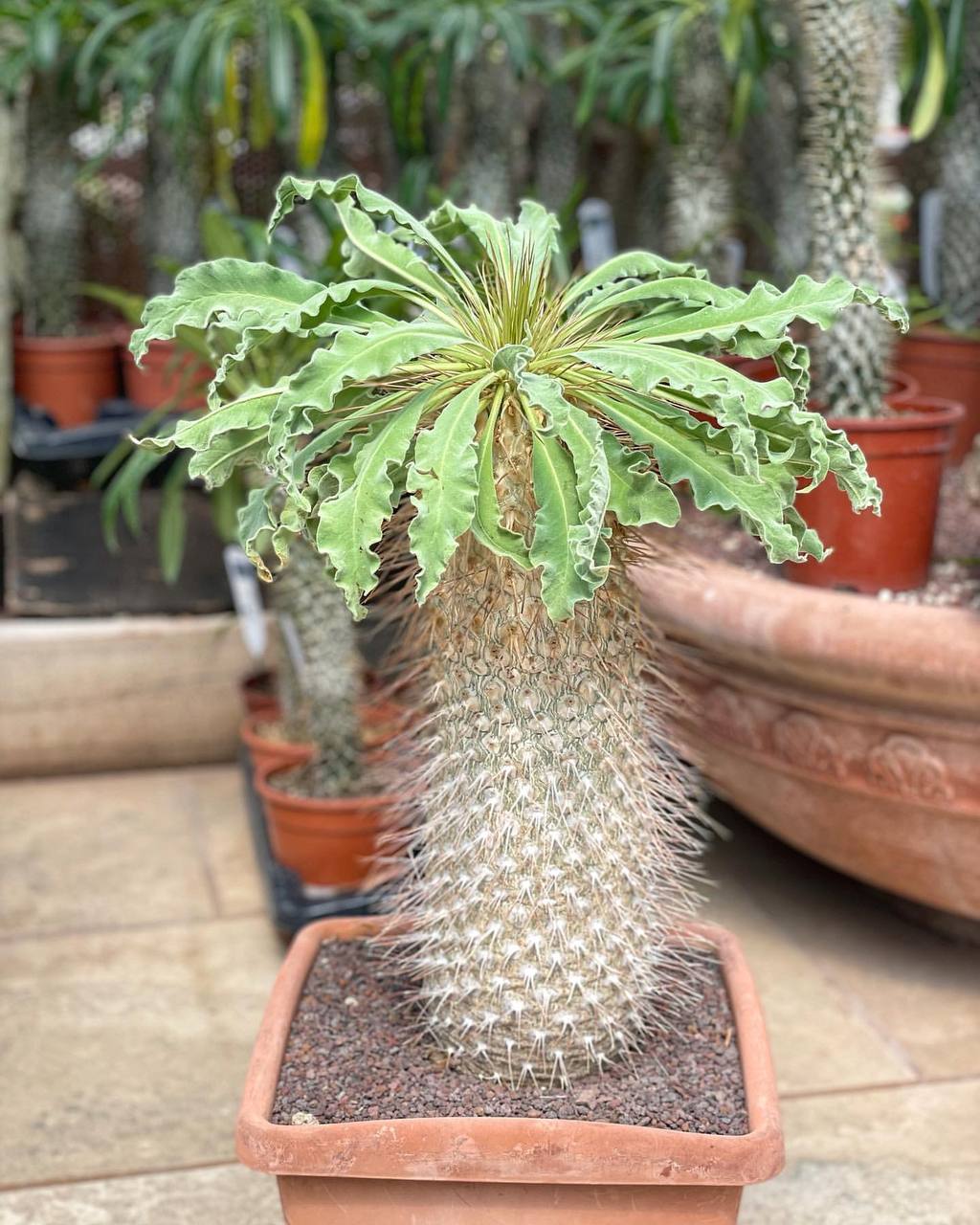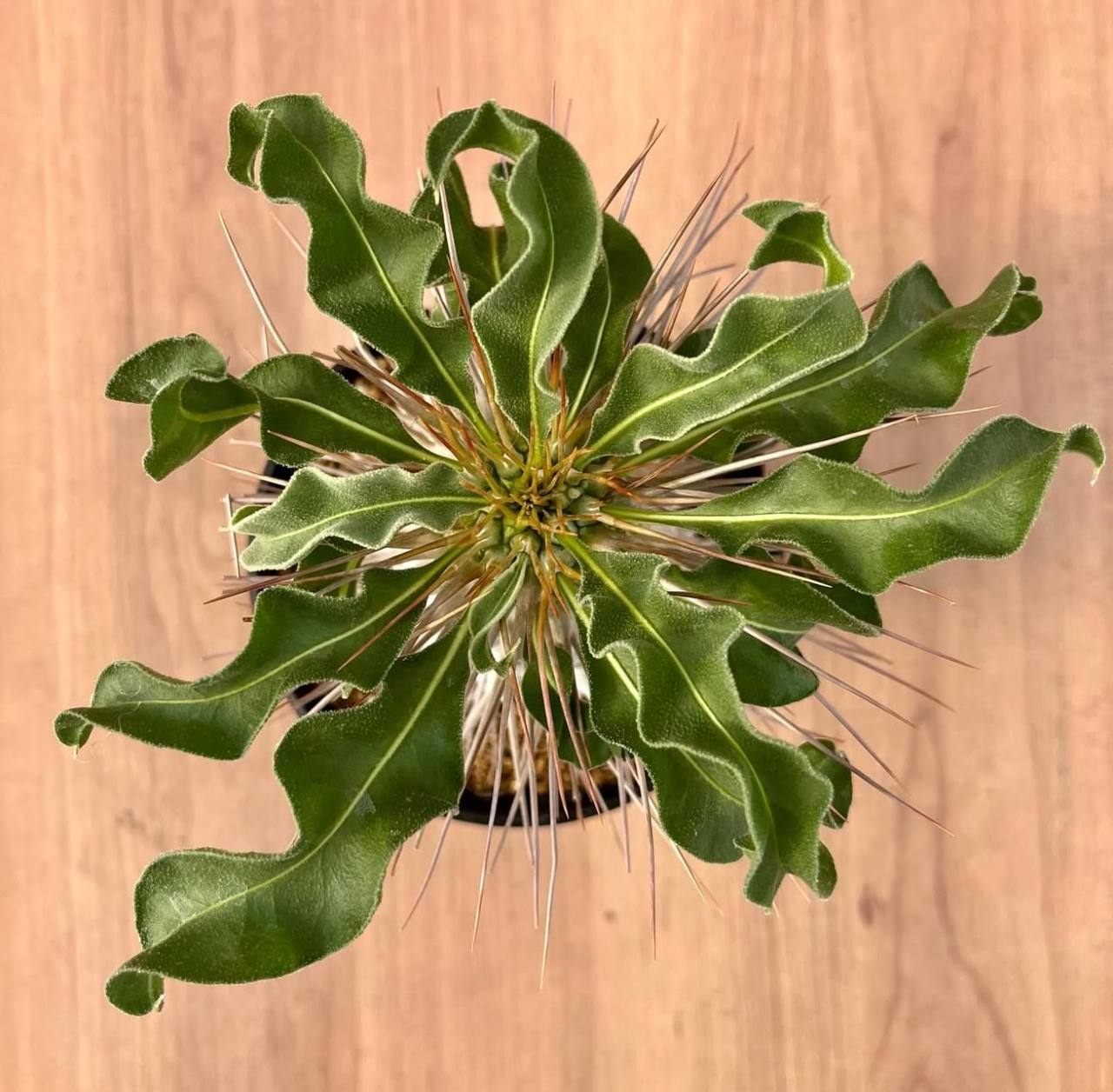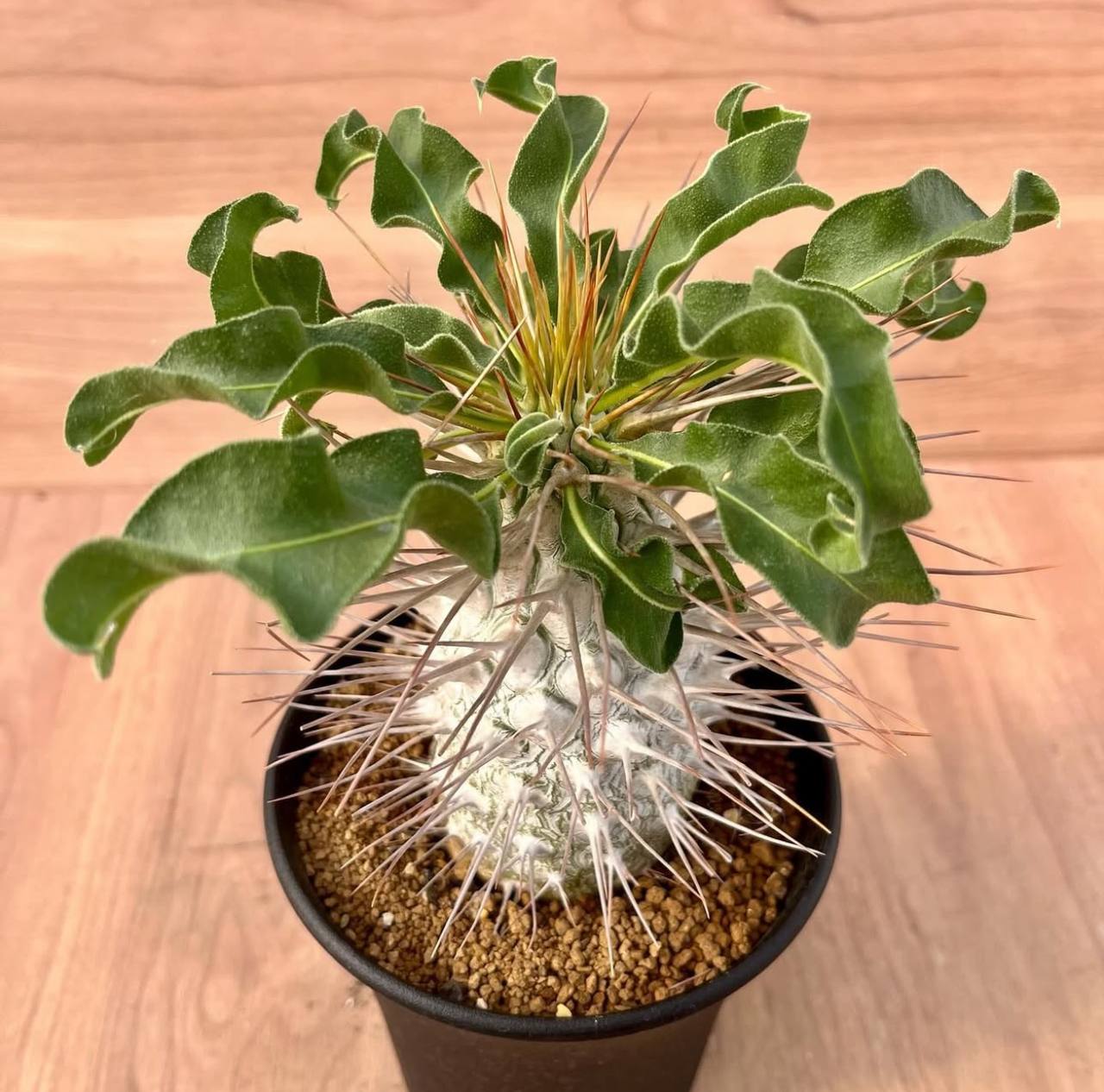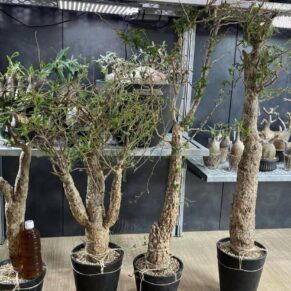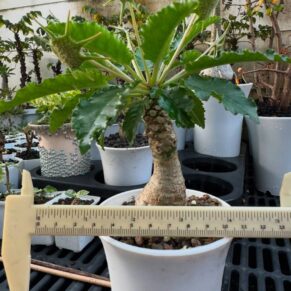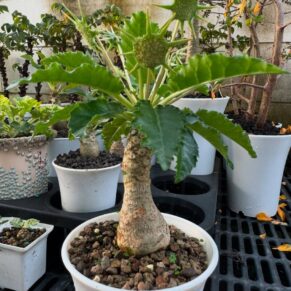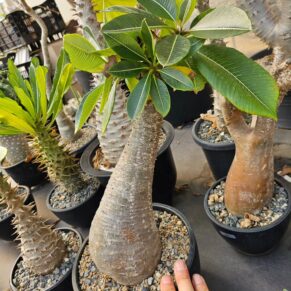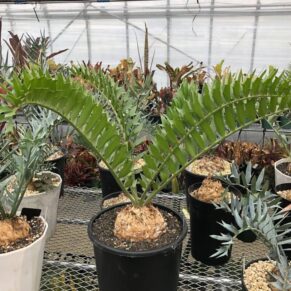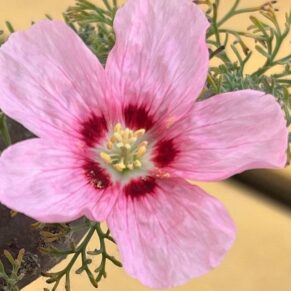- Your cart is empty
- Continue shopping
Shop
Pachypodium Namaquanum
Price range: $79.00 through $300.00
Pachypodium namaquanum, also known as the Halfmens, is a unique desert succulent from southern Africa, prized for its striking appearance and resilience in arid environments.
Pachypodium namaquanum: The Amazing “Halfmens” and Its Unique Characteristics
Introduction
Pachypodium namaquanum, commonly known as the Halfmens, is one of the most fascinating and unique plant species found in the arid regions of southern Africa. This succulent, part of the Apocynaceae family, is known for its striking appearance and its adaptability to the harsh environments of the Namibian and South African deserts. Facebook group.Its name, “Halfmens,” refers to the plant’s unusual shape, which often resembles human figures, with its thick, swollen trunk and spiny limbs.Shop P namaquanum here
Pachypodium namaquanum is not only admired for its distinctive look but also for its ability to thrive in some of the most challenging climatic conditions. This succulent has intrigued botanists, ecologists, and plant enthusiasts alike, and its unique adaptations make it an interesting subject of study for conservation efforts, horticulture, and sustainable gardening practices.
In this extensive guide, we will explore all aspects of Pachypodium namaquanum, including its taxonomy, characteristics, habitat, ecological role, cultivation, and uses. Additionally, we will address its conservation status and provide valuable insights into how this plant has become an important symbol of resilience and beauty in the face of extreme desert conditions.
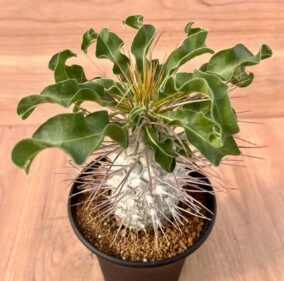
What Is Pachypodium namaquanum?
Pachypodium namaquanum is a distinctive succulent plant species native to the arid regions of southern Africa, primarily found in parts of Namibia and South Africa. This species is a member of the Pachypodium genus, which includes various succulents with varying forms and sizes, many of which are endemic to Madagascar and Africa. Known for its towering, tree-like shape, the Halfmens has garnered attention for its striking physical features, especially its swollen, thick trunk and its upright, spiny branches.Shop P namaquanum here
Taxonomy and Classification
Pachypodium namaquanum is classified as follows:
-
Kingdom: Plantae
-
Division: Angiosperms
-
Class: Eudicots
-
Order: Gentianales
-
Family: Apocynaceae
-
Genus: Pachypodium
-
Species: P. namaquanum
The genus Pachypodium contains several species, including those that are native to Africa and others that are indigenous to Madagascar. While some species are small shrubs or tree-like, Pachypodium namaquanum stands out due to its distinct appearance and the harsh environments it can thrive in.
Habitat and Distribution of Pachypodium namaquanum
Native Habitat
Pachypodium namaquanum is native to the Namaqualand region, which spans parts of northern Namibia and southern South Africa. The plant primarily grows in dry, rocky hills and desert scrublands, where the climate is harsh and water is scarce. This plant has evolved a range of adaptations that allow it to survive in the extreme conditions of the arid desert environment.
The native habitat of P namaquanum is characterized by:
-
Hot temperatures: Daytime temperatures often exceed 40°C (104°F) during the summer months.
-
Low rainfall: The region receives minimal precipitation, typically less than 100 mm (4 inches) annually.
-
Rocky, well-drained soils: Pachypodium namaquanum thrives in rocky terrains where the soil has good drainage, preventing water from pooling around the roots.
Climate and Environmental Conditions
The climate in the areas where P namaquanum grows is a defining factor in its ability to survive. These plants are adapted to extreme temperature fluctuations, with daytime highs and nighttime lows often varying by several degrees. During the hottest months, P namaquanum can endure intense sunlight, while its thick stem helps store water during periods of drought.Shop P namaquanum here
The plant’s environmental requirements include:
-
Dry conditions: It can survive extended periods without rainfall, relying on the moisture stored in its trunk.
-
Well-drained soil: This species requires a soil structure that prevents water from accumulating, as excess moisture can lead to root rot.
-
Full sun exposure: P namaquanum thrives in full sunlight, making it ideal for desert landscapes where sunlight is abundant.
Physical Characteristics of Pachypodium namaquanum
Size and Growth Form
Pachypodium namaquanum is a slow-growing, tree-like succulent that can reach significant heights. The plant can grow to an average height of 3 to 4 meters (10 to 13 feet), though some specimens may grow taller under optimal conditions. It has a single thick, swollen stem, which can appear somewhat bottle-shaped. The branches of the plant are sparse and spiny, resembling the outstretched arms of a human figure, hence its nickname, “Halfmens.”
Key physical characteristics of Pachypodium namaquanum include:
-
Swollen trunk: The trunk of the plant is swollen at the base, helping it store water to survive during droughts.
-
Spiny branches: Its branches are adorned with sharp, needle-like spines that protect the plant from herbivores and help it conserve moisture by reducing wind exposure.
-
Upright growth: Unlike many other succulents that spread outward, P namaquanum grows vertically, with its branches extending upward like the limbs of a human figure.
Leaves and Flowers
The leaves of P namaquanum are leathery, thick, and narrow, adapted to conserve moisture in the desert environment. These leaves are typically arranged in clusters at the tips of the branches. The plant’s flowers are another remarkable feature. They are large, funnel-shaped, and often appear in a variety of colors, including white, pink, and yellow. The flowering season typically occurs during the warmer months when the plant is able to store sufficient water.
-
Leaves: Long, narrow, and dark green, often clustered at branch tips, providing a balance between photosynthesis and water conservation.
-
Flowers: The plant produces large, showy flowers that are primarily pollinated by insects, adding a beautiful contrast to the stark desert landscape.
Ecological Role of Pachypodium namaquanum
As an iconic species in its native habitat, Pachypodium namaquanum plays an important ecological role. Its presence in the desert ecosystem is significant for several reasons:
-
Water storage: The plant’s thick, swollen trunk stores water, providing a resource for local wildlife during dry periods.
-
Erosion control: P namaquanum’s deep roots help prevent soil erosion by anchoring the soil and stabilizing the surrounding environment.
-
Wildlife support: While not a primary food source, the plant’s flowers attract pollinators, and its seeds provide sustenance to desert animals.
P namaquanum is a keystone species in its ecosystem, supporting biodiversity and maintaining the balance of desert habitats. Its unique adaptations also make it a valuable plant for understanding how life can thrive in extreme conditions.Shop P namaquanum here
Uses of Pachypodium namaquanum
Traditional and Medicinal Uses
Historically, indigenous peoples in southern Africa have used various parts of Pachypodium namaquanum for medicinal and cultural purposes. However, because of the plant’s slow growth and unique characteristics, it is not commonly harvested for these uses.
Some of the potential medicinal uses include:
-
Skin treatments: The latex or sap from P namaquanum has been used in some traditional remedies for its purported antimicrobial properties.
-
Pain relief: The plant’s sap has occasionally been applied to relieve pain or as a topical treatment for inflammation.
However, due to the protected status of P namaquanum in many regions, it is crucial that sustainable harvesting practices be employed to prevent overuse and preserve the plant for future generations.Shop P namaquanum here
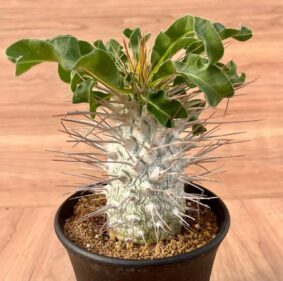
Modern Horticultural and Ornamental Uses
P namaquanum is increasingly popular in the horticultural and ornamental plant trade due to its striking appearance and its ability to thrive in desert landscaping projects. Its unusual form and ability to survive in harsh, low-water environments make it an ideal choice for xeriscaping and water-efficient gardens.
-
Ornamental landscaping: Because of its unique form, it is used as an ornamental plant in gardens, providing a sculptural focal point.
-
Succulent gardens: P namaquanum is a perfect addition to succulent gardens, offering a dramatic presence in both small and large landscapes.
This plant is also popular with collectors and succulent enthusiasts, who prize its unusual appearance and the challenge it presents in cultivation.
Cultivation and Care of Pachypodium namaquanum
Growing Conditions
Cultivating P namaquanum outside of its native environment requires an understanding of its specific growth needs. As a desert plant, it thrives in environments that mimic its natural habitat. Key factors to consider when cultivating P namaquanum include:
-
Sunlight: Full sunlight is crucial for the plant’s growth. It should be placed in a sunny spot where it can receive at least 6 hours of direct sunlight per day.
-
Soil: Well-drained, sandy, or gravelly soil is essential. The plant does not tolerate wet feet, so it’s important to ensure that the soil drains quickly to avoid root rot.
-
Watering: During the growing season, water sparingly. Overwatering can lead to root rot, so it is best to allow the soil to dry out completely between waterings.
Potting and Container Care
For those growing P namaquanum in containers, it is essential to choose a pot with excellent drainage to prevent water from accumulating at the bottom. Use a cactus or succulent mix and ensure that the container is large enough to accommodate the plant’s growing root system.Shop P namaquanum here
Temperature and Hardiness
P namaquanum is sensitive to cold temperatures and should be kept in environments where the temperature does not drop below 10°C (50°F). During the winter months, it is important to protect the plant from frost or cold drafts, especially if it is grown in a container.
Conservation of Pachypodium namaquanum
P namaquanum is listed as a protected species in some regions due to its unique characteristics and the fact that it is slow-growing and vulnerable to habitat degradation. Conservation efforts include:
-
Habitat protection: Efforts to preserve the Namaqualand region are crucial for protecting the natural habitat of P namaquanum.
-
Sustainable practices: Encouraging sustainable harvesting and cultivation techniques helps prevent the overuse of wild populations.
-
Research and awareness: Raising awareness about the plant’s importance and educating the public on how to care for it can contribute to its long-term preservation.
Conservation Threats
While not currently endangered, the primary threats to Pachypodium namaquanum include habitat destruction due to mining, agriculture, and urban development. Overcollection for ornamental purposes is also a concern, especially in areas where the plant is sold as a rare and exotic specimen.Shop P namaquanum here
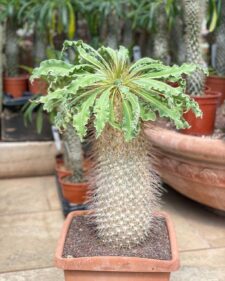
Conclusion
Pachypodium namaquanum is a remarkable and resilient species that exemplifies the beauty and adaptability of desert life. Its stunning appearance, slow growth, and unique survival mechanisms make it a prized plant for collectors and horticulturists alike. Whether in its native habitat or in cultivated environments, Pachypodium namaquanum serves as a testament to the wonders of nature, showcasing how plants can thrive in even the harshest conditions.
As we continue to explore and protect this fascinating species, it remains a symbol of both the fragility and strength of life in desert ecosystems. With careful conservation efforts and sustainable practices, Pachypodium namaquanum can continue to inspire future generations and add beauty to desert landscapes around the world.
| size | small, medium, large |
|---|

